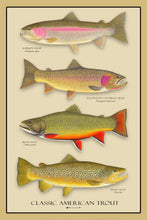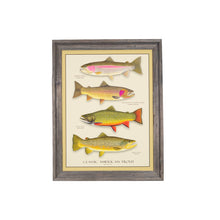Open-Edition Giclée prints are available as prints only and come with complimentary priority shipping within the continental United States. (All artwork is made-to-order. Prints ship within 3-4 days.)
The Classic American Trout Giclée Print is 18x24".
The History of four Classic American Trout:
Brown Trout
The Brown Trout is not an American native. The first brown trout (Salmo trutta), came to America in 1883, when Fred Mather, a New York farmer imported brown trout eggs from the president of the German Fishing Society, hence the common name German brown. Later, eggs from Loch Leven in Scotland arrived and were sent to the same fish hatcheries as Mather's eggs. The prevailing account is that these genetic stocks were mixed to create what Dr. Robert Behnke - "The Trout Doctor" (a world authority on the classification of salmonids), called "The American Generic Brown Trout". In 1884, 4,900 of these brown trout fry were released in Michigan, into the Baldwin river, a tributary of the Pere Marquette making them the first brown trout to swim free in U.S. waters
Yellowstone Cutthroat Trout
An American native, the Yellowstone Cutthroat trout was originally given the Latin name Salmo bouvierii, after a U.S. Army captain in 1883. Later, taxonomists lumped the Yellowstone Cutthroat and what we know now as the Westslope Cutthroat into a single subspecies, Salmo clarkii lewisii--named for the famous explorers, Lewis and Clark, who first encountered Cutthroat Trout on the Missouri River in 1805. Advances in genetics in the 1960s led scientists to divide the subspecies again, restoring the name bouvieri to the Yellowstone subspecies and coining the name "Westslope" for the other. Then, in 1989, all trout of the Pacific basin were moved out of the Salmo genus and into the Oncorhynchus genus, reflecting a closer relationship to Pacific salmon. The native range of the Yellowstone Cutthroat trout includes large areas of the Yellowstone and Snake river drainages including tracts of southern Montana, northwest Wyoming, southeast Idaho and parts of northern Utah and Nevada.
Rainbow Trout
Native to a narrow band along the Pacific coast of North America, the Rainbow Trout is one of the most prolific and widely-cultivated trout species in the world. German naturalist Johann Julius Walbaum named the species Oncorhynchus mykiss, based on rainbow trout encountered on Russia's Kamchatka Peninsula in 1792. Oncorhynchus means "hook-nosed" describing the kype of spawning males, and mykiss is derived from the Kamchatkan word for the fish mykizha. 44 years later, a Scottish biologist named Sir John Richardson encountered a trout in the Colombia River and named it Salmo gairdneri--after Meredith Gairdner, who gave him the specimen, and this was the most common Latin name used in angling literature for the next 150 years. Then in 1989, genetic studies determined that rainbow and cutthroat trout were too closely related to Pacific salmon (genus Oncorhynchus) than to brown trout and Atlantic salmon (genus Salmo), and Walbaum's original name, Oncorhynchus mykiss was restored.
Brook Trout
The native range of Salvelinus fontanalis, the American Brook trout, includes much of the northeastern part of North America and extends into the high Appalachian streams of Georgia and west to the Hudson Bay and Great Lakes region. Brook trout are the only native American trout species east of the Rocky Mountains and were an important food source for the original European settlers. Later, residents of New York and Boston would take trains to Vermont and Maine just to catch a trophy "squaretail", making the brook trout the first destination fish in the Americas.
Details
Prints:
These Giclée prints of Paul's original art are of the highest color quality and resolution available. The ink used for these prints is pigment-based, and is printed on acid-free, archival paper, resulting in a print that will last over 100 years without fading.
The 18x24" print size offered easily pairs with open frame sizes commonly found in stores. Prints are wrapped in pH neutral glassine paper and shipped in 3" crush-proof tubes.






